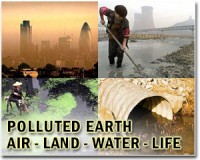| . |  |
. |
Venice, Louisiana (AFP) May 12, 2010 Chemical dispersants will be used to battle a massive Gulf of Mexico oil spill only as long as their environmental benefits outweigh the costs, the head of the US Environmental Protection Agency pledged Wednesday. More than 1.5 million liters (400,000 gallons) of dispersants have been sprayed across the massive slick spreading out of the wreckage of a BP-leased offshore rig which sank nearly three weeks ago. Environmentalists, scientists and fisherman have raised concerns that the dispersants could be creating a toxic soup in critical habitats and simply shifting the damage out of sight. "We're certainly aware we're running up a large gallonage of use here," EPA administrator Lisa Jackson said in a conference call with reporters. "But we're looking at a continued release (of crude from the leaking well) and an all-hands-on-deck effort to try to minimize the likelihood that this stuff hits those very fragile wetlands and marshes and those very valuable and much loved shorelines along the Gulf Coast." The dispersant effort is meant to break down the oil so that over time, the slick is reduced to smaller particles that biodegrade instead of being left as chunky, thick globs that can choke both wildlife and vegetation. Jackson acknowledged Wednesday that they come at an environmental cost, but said they are used to "move us towards the lesser of two difficult environmental outcomes." "Until we find a way to stem the flow of oil we must continue to take any responsible action that will mitigate the impact of the spill and that is what we are doing," Jackson said. "We absolutely must be aggressive in tackling the spill and at the same time we will take absolute care to ensure any efforts we take are not just substituting one challenge for another." BP, which is responsible for the cleanup, has ordered another three million liters (805,000 gallons) of dispersants of which 500,000 gallons is already staged for use to battle the estimated 795,000 liters (210,000 gallons) of crude gushing out of a leaking pipe some 1,524 m (5,000 feet) below the surface. "The hope would be we won't have to use all that," Jackson said. Officials are waiting for the results of three tests of subsurface dispersants, which could aid efforts by breaking up the crude sooner and -- since they would be deployed with robotic submarines =- could be applied even at night and during rough weather. Two initial tests were unable to determine their effectiveness and environmental impact due to logistical problems with getting the samples, Jackson said, adding that full-scale use will not begin until the method is deemed safe. "It's important to note that the dispersants that are being used are one tenth to one hundredth of the toxicity of oil," said Jane Lubchenco, who heads the National Oceanic and Atmospheric Administration. The plume that is formed with dispersants is degraded more rapidly than if the oil were to remain at the surface, she said. "It's not a case where we're simply transferring oil from the surface to the sea floor," she told reporters. There are "no good outcomes" with an oil spill, she said, explaining that the use of dispersants is a "tradeoff decision" aimed at minimizing the impact on shorelines, sensitive habitats, birds, mammals and marine life. "This oil spill is unprecedented and dynamic," she cautioned. "As situations change, and as we gain new information we need to continually reevaluate our response strategy, actions and planning." NALCO Energy Services of Sugar Land, Texas, manufactures the chemical dispersant for BP, which is known by its product name "Corexit." The dispersant is a low-level hazardous chemical, posing risks for eye and skin irritations and "chemical pneumonia" but not cancer, according to NALCO data posted on the Deepwater Horizon web site. The chemicals have been used on oil spills for years, including the notorious Exxon Valdez disaster in Alaska in 1989. Over the weekend, three top Louisiana officials from the departments of health, environmental quality, and wildlife & fisheries published a letter to BP chief executive Tony Hayward requesting more information on the chemical dispersants. The state officials said they had "serious concerns about the lack of information related to the use of dispersants in fighting the oil spill," as they asked for details on "what impact it could have on our people, water and air quality, as well as the wildlife, fisheries and vegetation."
Share This Article With Planet Earth
Related Links Our Polluted World and Cleaning It Up
 Sand dredging threatens Cambodia's coasts
Sand dredging threatens Cambodia's coastsPhnom Penh, Cambodia (UPI) May 12, 2010 Sand dredging in Cambodia, fueled by Singapore's expansion and land reclamation projects, poses a huge risk to Cambodia's coastal environment, says a new report. In its "Shifting Sands" report, environmental group Global Witness estimates that as much as 796,000 tons of sand is being removed from saltwater estuaries in Cambodia's Koh Kong province each month - enough to cover all of Ph ... read more |
|
| The content herein, unless otherwise known to be public domain, are Copyright 1995-2010 - SpaceDaily. AFP and UPI Wire Stories are copyright Agence France-Presse and United Press International. ESA Portal Reports are copyright European Space Agency. All NASA sourced material is public domain. Additional copyrights may apply in whole or part to other bona fide parties. Advertising does not imply endorsement,agreement or approval of any opinions, statements or information provided by SpaceDaily on any Web page published or hosted by SpaceDaily. Privacy Statement |